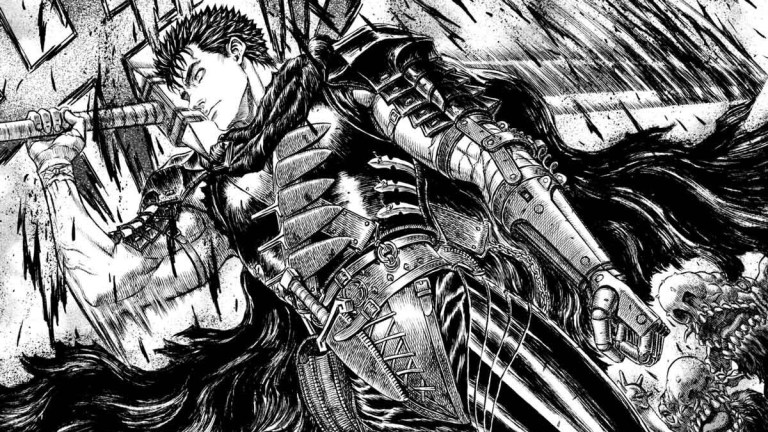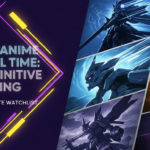What is Berserk Manga About?
For fans and newcomers alike, diving into the world of Berserk can be daunting with its intricate plot and deep themes. Understanding how this dark fantasy series weaves together its complex narrative can be a challenge. Berserk follows the story of Guts, a mercenary warrior, as he battles against fate, betrayal, and supernatural forces in a brutal, medieval-inspired world.
Are you ready to explore a tale that delves into the heart of darkness and the struggle for redemption? In this article, we’ll unravel the layers of Berserk, from its gritty plot and complex characters to its profound themes and lasting impact on the dark fantasy genre. Discover the tragic beauty of Guts’ journey and how the world of Berserk captivates its audience through its masterful storytelling. Keep reading to dive deep into what makes Berserk a timeless and unforgettable manga.
Key Facts:
- Berserk is a dark fantasy manga series created by Kentaro Miura in 1989.
- The story follows Guts, a mercenary warrior, in a medieval Europe-inspired world.
- Berserk explores themes of struggle, betrayal, and the nature of humanity.
- The series is renowned for its intricate artwork and complex character development.
- Berserk has had a significant influence on the manga and anime industry.
The Origins and Creation of Berserk
Berserk isn’t just another manga; it’s a cultural phenomenon that has captivated readers for decades. But where did this dark masterpiece come from? Let’s delve into the origins of this iconic series and the visionary mind behind it.
Kentaro Miura’s Vision
Kentaro Miura, the creator of Berserk, was a true artist in every sense of the word. Born in 1966, Miura showed an early aptitude for drawing, creating his first manga at the tender age of 10. But it wasn’t until 1989 that he would begin serializing Berserk, the work that would define his career and influence an entire genre.
Miura’s vision for Berserk was ambitious from the start. He wanted to create a dark fantasy world that was both brutally realistic and deeply philosophical. Drawing inspiration from diverse sources such as European mythology, medieval history, and existential philosophy, Miura crafted a universe that was as complex as it was compelling.
The Evolution of Berserk
Berserk’s journey from its initial conception to the sprawling epic we know today is a testament to Miura’s dedication and evolving artistry. The series began serialization in Hakusensha’s Monthly Animal House in 1989, later moving to Young Animal in 1992 where it continued until Miura’s untimely passing in 2021.

Kentaro Miura, the visionary creator of Berserk source
Over the years, Berserk’s art style and storytelling depth evolved dramatically. From the early, rougher sketches to the intricately detailed panels of later volumes, readers could witness Miura’s growth as an artist alongside the development of the story itself.
“I’m aiming for a path between reality and fantasy.” – Kentaro Miura
This quote encapsulates Miura’s approach to Berserk, blending gritty realism with fantastical elements to create a unique and immersive world.
Continuation After Miura’s Death
The passing of Kentaro Miura in 2021 left the future of Berserk uncertain. However, in a testament to the series’ enduring legacy, Miura’s close friend and fellow manga artist Kouji Mori, along with Studio Gaga (Miura’s team of assistants), announced their intention to continue the series. This decision, made with the blessing of Miura’s family, ensures that Guts’ journey will continue, guided by Miura’s notes and discussions with Mori.
Key Takeaway: Berserk is more than just a manga; it’s the life’s work of a visionary artist. Kentaro Miura’s dedication to his craft and his unique blend of dark fantasy and philosophical depth have created a series that continues to resonate with readers long after its inception.
What is Berserk Manga About: The Core Narrative
At its heart, Berserk is a tale of struggle against overwhelming odds, of betrayal, and of the indomitable human spirit. But what exactly is the story that has captivated readers for over three decades? Let’s break it down.
The World of Berserk
Berserk is set in a dark fantasy world heavily inspired by medieval Europe. This is no fairytale setting, however. The world of Berserk is brutal, unforgiving, and teeming with supernatural horrors. From war-torn kingdoms to demonic realms, the setting serves as a grim backdrop to the characters’ struggles.
The world-building in Berserk is intricate and immersive. Miura created a rich tapestry of cultures, religions, and political factions, each with their own motivations and conflicts. This depth adds layers of complexity to the narrative, making the world feel alive and lived-in.
The Protagonist: Guts
At the center of Berserk’s narrative is Guts, the Black Swordsman. Guts is a complex character, shaped by a life of violence and betrayal. Orphaned at birth and raised as a mercenary, Guts is a man defined by his struggle against fate.
Guts, the Black Swordsman, wielding his massive sword source
Guts’ journey is one of survival, revenge, and ultimately, redemption. From his early days as a lone mercenary to his time with the Band of the Hawk and his later quest for vengeance, Guts’ character development is a central focus of the series.
The Antagonist: Griffith
No discussion of what Berserk is about would be complete without mentioning Griffith, Guts’ former commander and the series’ primary antagonist. Griffith is the leader of the Band of the Hawk, a charismatic and ambitious man whose dream of ruling his own kingdom sets the stage for the series’ most tragic events.
Griffith’s relationship with Guts is complex and forms the emotional core of the series. Their friendship, rivalry, and ultimate betrayal drive much of the narrative and provide some of Berserk’s most poignant moments.
The Plot: A Journey Through Darkness
The plot of Berserk can be broadly divided into several major arcs:
- The Black Swordsman Arc: This arc introduces us to Guts as the Black Swordsman, seeking revenge against the God Hand and Apostles.
- The Golden Age Arc: A flashback arc that details Guts’ past, his joining of the Band of the Hawk, and the events that led to his current state.
- The Conviction Arc: Following the events of the Eclipse, this arc follows Guts’ quest for revenge and introduces new allies.
- The Millennium Falcon Arc: This arc sees Guts acquiring the Berserker Armor and journeying to Elfhelm.
- The Fantasia Arc: The ongoing arc that deals with the merging of the physical and astral worlds.
Each of these arcs builds upon the last, deepening the lore of the world and the complexity of its characters.
Key Takeaway: Berserk is a dark fantasy epic that follows the journey of Guts, a mercenary warrior, as he navigates a world of betrayal, supernatural horrors, and personal demons. Through its complex characters and intricate plot, Berserk explores themes of fate, free will, and the nature of humanity.
Themes and Analysis: The Heart of Berserk
What truly sets Berserk apart and makes it more than just another dark fantasy series are its deep, often philosophical themes. Let’s explore some of the core ideas that Miura wove into the fabric of his masterpiece.
The Struggle Against Fate
At its core, Berserk is about the struggle against fate. Guts, branded by the God Hand and seemingly destined for a life of suffering, constantly fights against the tide of causality. This theme is embodied in Guts’ famous quote:
“If you’re always worried about crushing the ants beneath you… you won’t be able to walk.”
This philosophy reflects Guts’ determination to forge his own path, regardless of the consequences. It’s a powerful message about free will and the human spirit’s resilience in the face of overwhelming odds.
The Nature of Ambition
Through Griffith’s character, Berserk explores the dark side of ambition. Griffith’s dream of his own kingdom drives him to commit unspeakable acts, raising questions about the cost of pursuing one’s goals at any price. This theme is particularly relevant in our modern world, where the pursuit of success often comes at a moral cost.
The Duality of Human Nature
Berserk doesn’t shy away from showing both the best and worst of humanity. Characters like Guts and Casca display tremendous courage and loyalty, while others like Griffith and the God Hand represent humanity’s capacity for cruelty and betrayal. This duality is a constant theme throughout the series, challenging readers to confront the complexities of human nature.
The Impact of Trauma
Trauma and its lasting effects are a central theme in Berserk. Guts’ journey is as much about overcoming his past traumas as it is about his physical battles. The series provides a nuanced look at PTSD and the struggle to find meaning after experiencing extreme violence and betrayal.
The Role of Religion and Faith
Berserk presents a complex view of religion and faith. The corrupt Church of the Holy See contrasts with characters like Farnese, who struggle with their faith. This exploration of religion raises questions about the nature of belief and the potential for both good and evil within religious institutions.
Key Takeaway: Berserk is more than just a tale of swords and sorcery. It’s a deep exploration of human nature, ambition, fate, and the struggle to find meaning in a cruel world. These themes elevate Berserk from a simple dark fantasy to a profound meditation on the human condition.
The Art of Berserk: A Visual Masterpiece
One cannot discuss what Berserk is about without acknowledging its stunning artwork. Kentaro Miura’s intricate, detailed art style is as much a part of Berserk’s identity as its story and themes.
Miura’s Unique Style
Miura’s art is characterized by its incredible detail and dynamic compositions. His ability to create sprawling, intricate landscapes and visceral action scenes is unparalleled in the manga world. The level of detail in each panel is astounding, from the intricate designs of armor and weapons to the grotesque forms of demons and monsters.

A detailed panel showcasing Miura’s intricate artwork source
Evolution of the Art
Over the course of Berserk’s publication, readers could witness Miura’s artistic evolution. From the rougher, more angular style of the early chapters to the refined, hyper-detailed work of later volumes, Miura’s growth as an artist paralleled the deepening complexity of the story.
Visual Storytelling
Miura’s art does more than just illustrate the story; it tells it. His use of panel layout, perspective, and visual metaphor adds layers of meaning to the narrative. The contrast between light and shadow, the grotesque forms of the Apostles, and the haunting beauty of the more fantastical elements all contribute to the series’ unique atmosphere.
Influence on the Industry
Berserk’s art style has had a significant influence on the manga and anime industry. Its dark, detailed aesthetic has inspired countless other works, from manga like Vinland Saga to video games like the Dark Souls series.
Key Takeaway: The artwork of Berserk is an integral part of its storytelling. Miura’s intricate, evolving style not only brings the dark fantasy world to life but also adds depth and nuance to the narrative, setting a new standard for visual storytelling in manga.
The Legacy of Berserk: Impact and Influence
Berserk’s influence extends far beyond the pages of manga. Let’s explore how this dark fantasy epic has left its mark on popular culture and the entertainment industry.
Influence on Manga and Anime
Berserk has been a major influence on the dark fantasy genre in manga and anime. Its gritty realism, complex characters, and mature themes have inspired countless other works. Series like Attack on Titan and Claymore show clear influences from Berserk in their tone and themes.
Impact on Video Games
The influence of Berserk on video games cannot be overstated. The most notable example is the Dark Souls series, which draws heavy inspiration from Berserk in its dark medieval setting, challenging gameplay, and grotesque enemy designs. Other games like Dragon’s Dogma and Bloodborne also show clear Berserk influences.
Cultural Impact
Berserk has become a cultural touchstone, particularly in discussions about dark fantasy and mature storytelling in manga. Its exploration of complex themes and unflinching portrayal of violence and human nature have made it a subject of academic study and critical analysis.
A Dedicated Fanbase
Despite its often challenging content, Berserk has cultivated a dedicated and passionate fanbase. The depth of its story and characters has inspired countless discussions, theories, and fan works. The series’ long-running nature and Miura’s occasional hiatuses only seemed to fuel fans’ dedication.
Adaptations and Merchandise
Berserk has seen several adaptations over the years, including:
- The 1997 anime series
- The Golden Age Arc film trilogy (2012-2013)
- The 2016-2017 anime series
While these adaptations have received mixed reviews, they’ve helped introduce new audiences to the world of Berserk. Additionally, a wide range of Berserk merchandise, from figurines to replicas of Guts’ sword, demonstrates the series’ enduring popularity.
Key Takeaway: Berserk’s legacy extends far beyond its own pages. Its influence can be seen in manga, anime, video games, and broader popular culture, cementing its status as a true classic of the dark fantasy genre.
FAQs About What is Berserk Manga About
Q: What is the main story of Berserk manga?
A: The main story of Berserk manga follows Guts, a skilled mercenary warrior, as he seeks revenge against his former commander Griffith, who sacrificed their mercenary band to become a powerful demon. Set in a dark fantasy world inspired by medieval Europe, the story explores themes of fate, ambition, and the struggle against overwhelming odds.
Q: Is Berserk manga suitable for all ages?
A: No, Berserk manga is not suitable for all ages. It contains graphic violence, sexual content, and mature themes that make it appropriate only for adult readers. The series is categorized as seinen manga, which is aimed at adult male readers.
Q: How long is the Berserk manga series?
A: As of 2023, the Berserk manga series consists of 41 volumes. The series began in 1989 and continued until the passing of its creator, Kentaro Miura, in 2021. It is currently being continued by Miura’s assistants and close friend Kouji Mori, based on Miura’s notes and discussions.
Q: What makes Berserk stand out among other manga series?
A: Berserk stands out due to its intricate artwork, complex characters, dark and mature themes, and philosophical depth. Kentaro Miura’s detailed illustrations, the series’ exploration of human nature, and its blend of medieval fantasy with horror elements create a unique and compelling narrative that has influenced numerous other works in manga, anime, and video games.
Q: Is the Berserk manga finished?
A: No, the Berserk manga is not finished. Although creator Kentaro Miura passed away in 2021, the series is being continued by Studio Gaga (Miura’s assistants) and supervised by Kouji Mori, Miura’s close friend who was familiar with the planned story. The continuation aims to complete the series based on Miura’s notes and discussions.
Q: What are the main themes explored in Berserk?
A: Berserk explores several profound themes, including:
- The struggle against fate
- The nature of ambition and its consequences
- The duality of human nature
- The impact of trauma and resilience
- The role of friendship and betrayal
- The exploration of free will versus determinism
- The critique of organized religion and power structures
Summary
What is Berserk manga about? At its core, Berserk is a dark fantasy epic that follows the journey of Guts, a skilled mercenary warrior, as he battles against fate, demons, and his own inner darkness in a medieval-inspired world. Created by Kentaro Miura, this manga series has captivated readers for decades with its intricate artwork, complex characters, and profound themes.
Berserk is more than just a tale of swords and sorcery; it’s a deep exploration of human nature, ambition, and the struggle to find meaning in a cruel world. Through Guts’ relentless pursuit of revenge and redemption, readers are confronted with challenging questions about fate, free will, and the cost of ambition.
As you delve into the world of Berserk, consider this: How far would you go to defy your fate? What price would you pay to achieve your dreams? Berserk invites us to confront these questions and more, offering a reading experience that is as thought-provoking as it is visually stunning.



